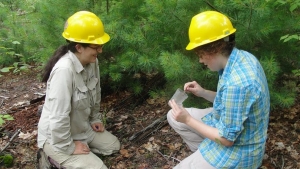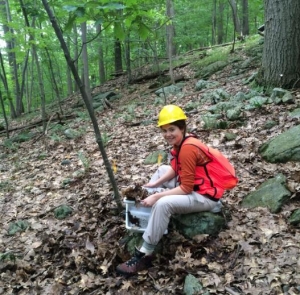You are here
Ant-ticipating Change: As forests change, will ants?
 Ants work hard. In fact, a single leafcutter colony can consume more than the average cow. But different ants work hard in different ways. Some will move seeds around, letting plants grow in new areas. Some will build vast underground tunnels that aerate the soil. Different kind of ants are useful. That's where I come in.
Ants work hard. In fact, a single leafcutter colony can consume more than the average cow. But different ants work hard in different ways. Some will move seeds around, letting plants grow in new areas. Some will build vast underground tunnels that aerate the soil. Different kind of ants are useful. That's where I come in.
I do two things. I figure out what ants we're working with, and I figure out what ants we will be working with. Here at Harvard Forest and at Black Rock Forest, I am looking at how the numbers and types of species of ant has changed over time, and how they will change. Our forests are under threat from two different tree-killing blights. Wooly adelgid, an invasive insect, kills off eastern hemlock, and Sudden Oak Death kills off oak.
Woolly adelgid is already in Harvard Forest's hemlocks, and Black Rock Forest is at risk of a Sudden Oak Death (SOD) outbreak. Our forests are changing, and we're trying to predict how the ant communities, and the skills they offer, will change with them.
What does this mean I do all day? I poke logs mostly. This last week, my mentor Sydne Record and I collected samples of nests in Black Rock Forest. That means that for 25 minutes per plot, I got to turn over every rock, kick every stump, and crawl through dead leaves – all in the name of science!
 When I’m not frolicking in the forest looking for ants, I am either ID-ing the species of ant or coding in R trying to analyze them. It’s all fun work. Now I can pick up an ant and just know its genus, which is the closest thing to a super power I’ve ever had. But I have to admit, the coding is my favorite part, because you really get to play with your data. Whether it’s in class or for research, it’s really fun to tease a story out of data. I can’t wait to see what stories these ants will tell!
When I’m not frolicking in the forest looking for ants, I am either ID-ing the species of ant or coding in R trying to analyze them. It’s all fun work. Now I can pick up an ant and just know its genus, which is the closest thing to a super power I’ve ever had. But I have to admit, the coding is my favorite part, because you really get to play with your data. Whether it’s in class or for research, it’s really fun to tease a story out of data. I can’t wait to see what stories these ants will tell!


